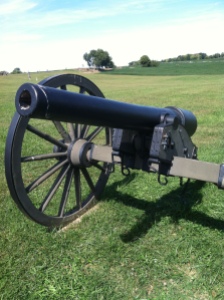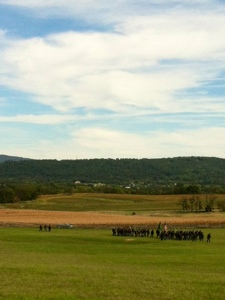Day One of the A to Z Challenge! I’m so proud of myself for following through with Day One and not epically failing in between yesterday’s declaration of taking part in the challenge and then actually…you know, taking part in the challenge.
So. Day one. A.
In the Heather Hambel Curley Book of Letters (sounds like a Dr. Who plot point), A stands for Antietam.
 As I may have mentioned once or twice, I kind of dig Antietam. The small, shall we say picturesque town of Sharpsburg was in the wrong place at the wrong time in September of 1862, when the Union and Confederate armies planted themselves down and glared at each other from across the fields, waiting for daybreak. At the dying of night-before 6am- they ripped into each other with an artillery barrage.
As I may have mentioned once or twice, I kind of dig Antietam. The small, shall we say picturesque town of Sharpsburg was in the wrong place at the wrong time in September of 1862, when the Union and Confederate armies planted themselves down and glared at each other from across the fields, waiting for daybreak. At the dying of night-before 6am- they ripped into each other with an artillery barrage.
The battle itself lasted approximately 13 hours, during which there were 27,000 casualties. Men were literally torn to shreds. The glint of sunlight off the bayonets of men hidden in The Cornfield results in mass casualties when artillery is turned on them. The Sunken Road, no more than a farm path, has bodies stacked in it, bloodied mangled corpses photographed after the battle.
Medical triage is pretty basic: save those you know you can save and leave the rest. Head wounds, belly wounds, chest wounds are left on the field. Those you might be able to save are hauled to a field hospital. Wounds are packed with morphine. The men wait.
The problem with soft lead that was used in Civil War bullets is that it decimates bone. The bone shatters and all those little shards of bone explode into surrounding flesh. If you leave those shards where they are, it’s going to be painful. It’s going to get infected. And you’re probably going to amputate in the long run.
So you amputate now.
A good rule of thumb seems to be to amputate at the next joint up: for example, amputate at the elbow for a wound in the forearm. The surgeons were fast. Limbs piled up outside of public buildings, such as the shelled churches in town.
When the battle ended and the armies left, the population of Sharpsburg was left with the dead. Bodies were buried where they fell, the corpses of horses were burned. Citizens wrote how, as they approached town, they were hard pressed to find a place to step that wasn’t covered with a corpse.
I read an article that a few weeks after the battle, a farmer was plowing his fields and found the severed arm of a soldier. He preserved in alcohol and eventually it was preserved properly, remaining on display in a private collection until recently. The Civil War Medical Museum had tests done on it prior to the 150th Anniversary of the battle. It was determined it was a young individual. The arm was wrenched from the joint, the twisting damage most likely done by artillery.
27,000 in 13 hours.
Antietam is, technically, a tactical draw. Lee is never pushed from the field. But it’s enough of a victory for Lincoln to issue his Emancipation Proclamation.
Antietam plays a pretty substantial role in the first half of my novel, starting out with Jeb Stuart’s Roses and Sabers Ball and culminating with the battle itself. Unfortunately Jeb Stuart’s role in the actual battle was on the ho-hum side, since he was evidently on Nicodemus Hill most of the time. Just being awesome I guess. Or, as Dorsey Pender said of him, “calculating.”
I haven’t gotten confirmation from The Hubs that we’re going to Antietam this year. I’ll be bummed if we don’t. Most of my vacation time is being spent on not one, BUT TWO trips to Gettysburg. As the kids say, woot woot.
 Antietam has become my happy place. It’s the screen saver on my computer at work (actually, it’s a picture of The Hubs firing artillery at Antietam!), it’s the case on my iPhone, it’s like, five chapters in my novel. I recommend going, if you can, and walking across Burnside’s Bridge or through Bloody Lane. It’s silent now. But the tragedy remains.
Antietam has become my happy place. It’s the screen saver on my computer at work (actually, it’s a picture of The Hubs firing artillery at Antietam!), it’s the case on my iPhone, it’s like, five chapters in my novel. I recommend going, if you can, and walking across Burnside’s Bridge or through Bloody Lane. It’s silent now. But the tragedy remains.
For more information, visit the National Park Service’s website by clicking here.
I knew nothing of Antietam and now know lots. You painted the images so they are etched on my mind. Great start to the challenge. Well done for, you know.. taking part.. may we both take part in the rest too!
Thank you for your kind words! I’m pretty excited about the A to Z challenge. I’m glad I could start out with Antietam though, since it’s one of my favorite places. Oddly enough, B is trickier for me. Baking is, of course, the first thing that comes to mind!